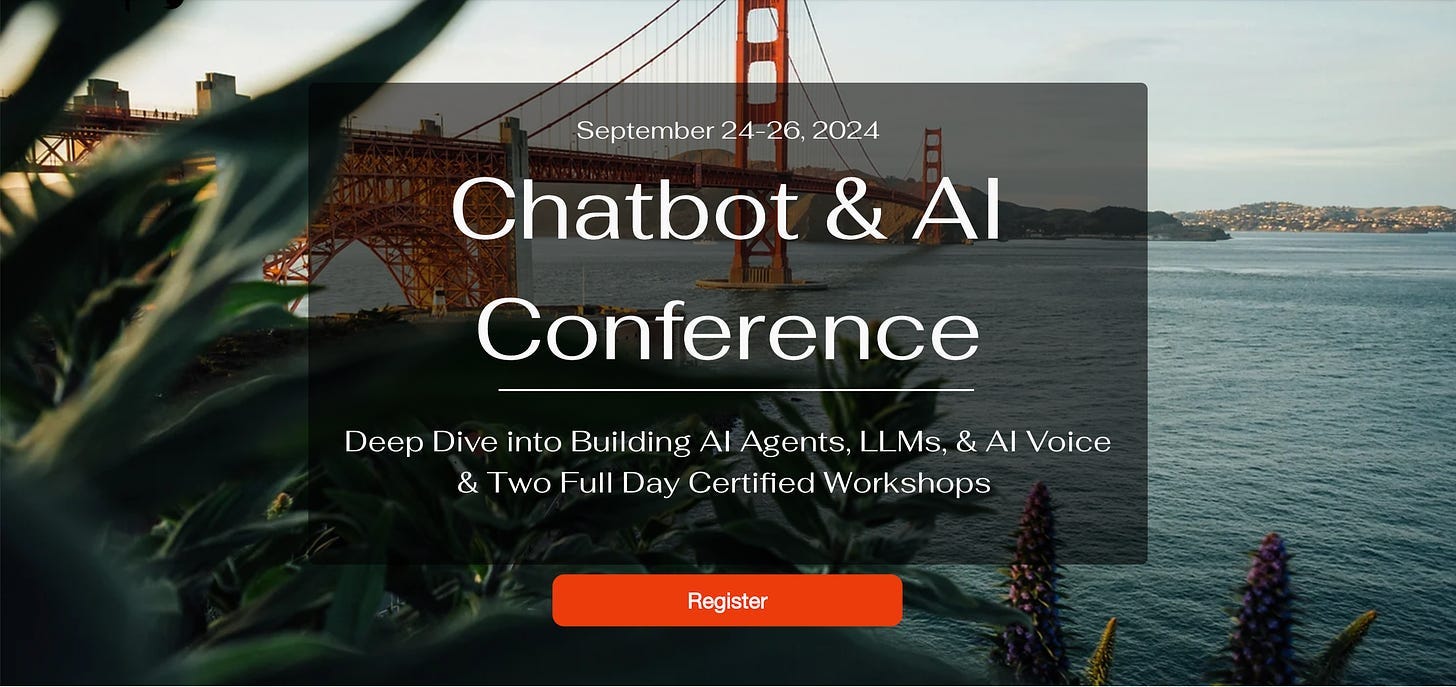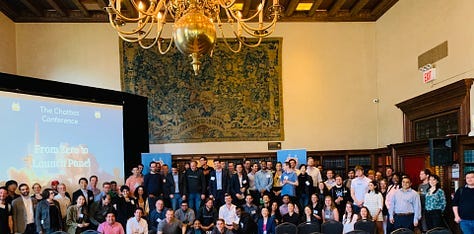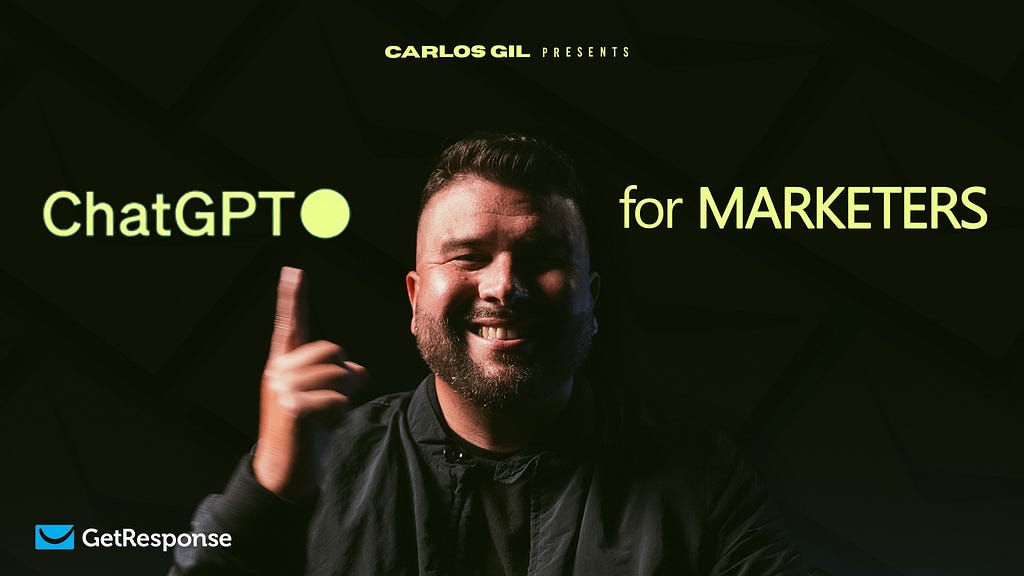The Impact of ChatGPT on Search Engine Marketing Strategies
AI vs. Human Creativity: How Generative AI is Transforming Innovation in 2025
ChatGPT, DeepSeek Banned in India’s Finance Ministry Amid Privacy Fears
How DeepSeek is Making AI More Affordable for Startups
ChatGPT to DeepSeek: Evolving Competition Among AI Virtual Assistants
Nvidia Leads Charge in AI Investments, Outpacing Tech Giants
Unlock the Future: AI Agents and LLMs at Chatbot Conference 2024
Unveiling the Speakers, Agenda and Theme of Chatbot Conference 2024
Dear AI Enthusiasts,
We’re thrilled to unveil the agenda for this year’s Chatbot Conference, scheduled for September 24–26 in the tech-savvy city of San Francisco.
This year, we’re zeroing in on a groundbreaking theme: AI Agents and LLMs — The Tools That Do More Than Answer; They Act.

Why AI Agents?
Our previous forays included early discussions on revolutionary technologies like ChatGPT and NLG back in 2019, and we even pioneering virtual conference in the Metaverse in 2022.
This year, we’re diving deeper into AI agents — LLMs designed not just to respond, but to perform actions, driving automation and efficiency across sectors.

Featured Speakers:
This year’s lineup includes some of the foremost thinkers in AI and conversational design:
- Braden Ream, CEO at Voiceflow: Discussing trends in bot building and their value in real-world applications.
- Vaibhavi Gangwar, Co-founder at Maxim AI: Offering insights into deploying effective LLM-powered chatbots.
- Jack C. Crawford, Former VP of Gen AI at Wells Fargo: Sharing strategies for implementing AI in regulated industries.
- Alea Abrams, CUX & Gen AI at ServiceNow: Exploring the use of mental models for enhanced AI interactions.
- Dustin Dye, Co-founder & CEO at BotCopy: Reimagining the future of websites and digital interactions
And of course, we have many more speakers!
Agenda Highlights:
Every year, we put a lot of thought into our agenda. We like to organize it in such a way that content flows from one topic to the next.
Typically, we start with the Big Picture to see where we are now and identify what is working.
This year’s Morning Sessions are about seeing the Big Picture and the afternoon sessions focus on execution.
- Unleashing AI Agents: Discover how AI agents are revolutionizing automation and enhancing digital workflows.
- The Big Picture Panel: A deep dive into current trends and future directions for AI and LLMs.
- Future of AI & LLMs: Gain Google’s latest insights into the evolution of these transformative technologies.
- The 10 Impediments to LLM Adoption: Discover what is holding the implimentation of LLMs back.
- Rags to Riches: Designing and Building Multi-Agent Architectures
- Ethical AI: Addressing biases and building trust within intelligent systems.

Workshops & Certification Programs:
Day 2 and Day 3 will feature full-day certified workshops focused on:
- Conversational UX: Design effective AI agents with a focus on user experience.
- AI & LLM Development: From theory to practice — build and deploy your AI agent.
Why Attend?
- Discover what is working from the top industry experts and practitioners.
- Network with pioneers and peers in the industry.
- Build and launch your own AI agent with direct guidance from leading developers.
What’s it Like to Attend?

Our conference is more than just talks and workshops; it’s an incubator for ideas and partnerships. Attendees leave not just with knowledge, but with actionable insights and new connections that can propel their careers and ventures forward.

Join Us
Don’t miss out on the opportunity to be at the forefront of AI technology. Register now to secure your spot at the Chatbot Conference 2024, where the future of AI comes to life.
Register Now: Chatbot Conference 2024 Registration
Looking forward to welcoming you to an event filled with innovation, learning, and networking!
Warm regards,
The Chatbot Conference Team

P.S. Space is limited, and our early bird tickets are going fast! Secure your spot today to be part of the AI revolution.
If you still have any questions about the Conference, check out our Testimonials below 👇
What Attendees Say about the Chatbot Conference
Unlock the Future: AI Agents and LLMs at Chatbot Conference 2024 was originally published in Becoming Human: Artificial Intelligence Magazine on Medium, where people are continuing the conversation by highlighting and responding to this story.
Why does AI hallucinate?

On April 2, the World Health Organization launched a chatbot named SARAH to raise health awareness about things like how to eat well, quit smoking, and more.
But like any other chatbot, SARAH started giving incorrect answers. Leading to a lot of internet trolls and finally, the usual disclaimer: The answers from the chatbot might not be accurate. This tendency to make things up, known as hallucination, is one of the biggest obstacles chatbots face. Why does this happen? And why can’t we fix it?
Let’s explore why large language models hallucinate by looking at how they work. First, making stuff up is exactly what LLMs are designed to do. The chatbot draws responses from the large language model without looking up information in a database or using a search engine.
A large language model contains billions and billions of numbers. It uses these numbers to calculate its responses from scratch, producing new sequences of words on the fly. A large language model is more like a vector than an encyclopedia.
https://medium.com/media/260ffdc0d69d4e1186a4969c41c75c63/href
Large language models generate text by predicting the next word in the sequence. Then the new sequence is fed back into the model, which will guess the next word. This cycle then goes on. Generating almost any kind of text possible. LLMs just love dreaming.
The model captures the statistical likelihood of a word being predicted with certain words. The likelihood is set when a model is trained, where the values in the model are adjusted over and over again until they meet the linguistic patterns of the training data. Once trained, the model calculates the score for each word in the vocabulary, calculating its likelihood to come next.
So basically, all these hyped-up large language models do is hallucinate. But we only notice when it’s wrong. And the problem is that you won’t notice it because these models are so good at what they do. And that makes trusting them hard.
Can we control what these large language models generate? Even though these models are too complicated to be tinkered with, few believe that training them on even more data will reduce the error rate.
You can also ensure performance by breaking responses step-by-step. This method, known as chain-of-thought prompting, can help the model feel confident about the outputs they produce, preventing them from going out of control.
But this does not guarantee 100 percent accuracy. As long as the models are probabilistic, there is a chance that they will produce the wrong output. It is similar to rolling a dice even if you tamper with it to produce a result, there is a small chance it will produce something else.
Another thing is that people believe these models and let their guard down. And these errors go unnoticed. Perhaps, the best fix for hallucinations is to manage the expectations we have of these chatbots and cross-verify the facts.
Why does AI hallucinate? was originally published in Becoming Human: Artificial Intelligence Magazine on Medium, where people are continuing the conversation by highlighting and responding to this story.
Top AI chatbots of 2024
Master ChatGPT: A Step-by-Step Guide to Transform Your Marketing with AI

What’s going on everyone? It’s Carlos Gil, author of The End of Marketing: H umanizing Your Brand in the Age of Social Media and AI. Five years ago, when I wrote this book, I aimed to provide businesses and marketing professionals with a guide to future-proof their brands and careers. As we face the inevitable rise of AI, it’s clear that marketing jobs, from copywriting to community management, are being disrupted. This post is designed to teach you how to integrate AI into your marketing workflow, making you more efficient and setting you up for long-term success. Let’s dive into how you can master ChatGPT to transform your marketing efforts.
https://medium.com/media/f061a9446a5f291510be528de4a22c38/href
Why ChatGPT?
ChatGPT is a powerful AI tool developed by OpenAI that can generate human-like text based on the prompts you provide. It has saved me a lot of time and enhanced my creativity, making it an invaluable tool for modern marketers. From writing social media posts to crafting email campaigns, ChatGPT can significantly streamline your workflow.
Setting Up ChatGPT
1. Accessing ChatGPT
Visit the OpenAI website and sign up for an account. Depending on your needs, you can choose a free or paid plan. Once you have access, familiarize yourself with the interface where you can input prompts and customize the output settings.
2. Understanding Prompts
Prompts are the instructions you give to ChatGPT. The clearer and more detailed your prompts, the better the output. For example, instead of saying, “Write a social media post,” specify, “Write a humorous social media post about our new product launch.”
Using ChatGPT for Marketing
Crafting Social Media Posts
Social media is a crucial aspect of modern marketing. ChatGPT can help you create engaging posts that resonate with your audience.
Step-by-Step Guide:
- Define Your Objective: Decide the purpose of your post — whether to inform, entertain, or promote a product.
- Set the Tone and Style: Specify the tone (e.g., humorous, professional) and style (e.g., casual, formal) in your prompt.
- Provide Key Information: Include essential details such as the product name, features, and hashtags.
- Generate the Post: Input the prompt into ChatGPT. For example: “Write a playful social media post about our new eco-friendly water bottle. Mention its benefits and use the hashtag #GoGreen.”
- Review and Edit: Review the generated post and make necessary edits to align it with your brand voice.
Managing Google Reviews
Google reviews are essential for small businesses. ChatGPT can help you efficiently respond to reviews in your brand’s voice.
Step-by-Step Guide:
- Generate Responses: Ask ChatGPT to write responses for common types of reviews. For example: “Write a response to a positive review about our customer service.”
- Customize Responses: Tailor the generated responses to fit the specific context and tone of your brand.
- Copy and Paste: Use the generated responses to quickly reply to reviews, saving time and maintaining consistency.
Writing Email Campaigns
Email marketing is a powerful tool for engaging customers. ChatGPT can assist in writing persuasive and personalized email content.
Step-by-Step Guide:
- Segment Your Audience: Identify the target audience for your email campaign.
- Define the Purpose: Determine the goal of your email, such as promoting a sale or announcing a new product.
- Craft a Compelling Subject Line: Ask ChatGPT to generate subject line options. Example prompt: “Generate 5 subject lines for a promotional email about our summer sale.”
- Write the Email Body: Provide ChatGPT with the necessary details. Example prompt: “Write an email body for our summer sale. Mention discounts, highlight popular products, and include a call-to-action.”
- Personalize the Content: Use placeholders for personalization (e.g., Customer Name) and refine the content to make it feel personalized.
Optimizing SEO Content
SEO is vital for improving your website’s visibility. ChatGPT can assist in optimizing your content for search engines.
Step-by-Step Guide:
- Identify Keywords: Research and select relevant keywords for your content.
- Optimize Titles and Descriptions: Use ChatGPT to create SEO-friendly titles and meta descriptions. Example prompt: “Generate a meta description for a blog post about AI in marketing using the keyword ‘AI marketing benefits’.”
- Enhance Content: Ask ChatGPT to rewrite sections of your content to include keywords naturally. Example prompt: “Rewrite this paragraph to include the keyword AI marketing benefits.”
Improving Sales Communication
Effective sales communication can significantly boost your conversion rates. ChatGPT can help you create personalized and engaging sales emails and LinkedIn messages.
Step-by-Step Guide:
- Define Your Audience: Specify the job title and industry of the individual you’re targeting.
- Craft Engaging Subject Lines: Ask ChatGPT to write email subject lines that don’t read as a pitch. Example prompt: “Write a subject line for an email to a marketing director about a new software tool.”
- Personalize the Message: Provide context about your offering and let ChatGPT generate the email body. Example prompt: “Write a LinkedIn message to a marketing director introducing our new AI tool.”
Best Practices for Using ChatGPT
- Be Specific: The more detailed your prompts, the better the output. Include as much context and information as possible.
- Review and Edit: Always review and edit the generated content to ensure it aligns with your brand voice and messaging.
- Stay Consistent: Use ChatGPT consistently across different marketing channels to maintain a cohesive brand voice.
- Experiment and Learn: Experiment with different prompts and approaches to find what works best for your audience.
Leveraging GetResponse’s AI Tools
While ChatGPT is a fantastic tool for generating content, GetResponse offers additional AI-powered tools that can further enhance your email marketing efforts.
AI Email Generator
GetResponse’s AI Email Generator helps you create engaging emails in record time. Powered by OpenAI, this tool can generate industry-specific email content and subject lines optimized for your goals.
Key Features:
- OpenAI Innovation: Boost your impact with the latest OpenAI technology integrated into your email marketing software.
- AI Subject Line Generator: Get more opens with AI-optimized subject lines that stand out in your subscribers’ inboxes.
- Industry-Specific Optimization: Effortlessly create emails tailored to your business based on keywords and industry trends.
- Multilingual Support: Generate content in the language of your audience and save time on translations (coming soon).
How to Generate an AI Email Template
Thanks to OpenAI technology, you can create an entire email in just a few clicks. Here’s how:
- Define Your Email Goal: Type keywords or phrases relevant to your email goal, and choose a category that best suits your business.
- Set the Tone: Select the tone that matches the sentiment you’re looking to communicate.
- Choose the Design: Set the layout and color scheme. If your layout features an image, the template will include a relevant stock photo from our free images library.
- Customize and Send: Add a few custom touches if needed, and send.
GetResponse customers using the AI email generator have seen an 85% decrease in email creation time, allowing for more efficient and effective marketing campaigns.
A/B Testing and Optimization
With GetResponse’s AI tools, you can continuously test and optimize your email campaigns to increase open and click-through rates. Use the AI subject line generator to experiment with different subject lines and find what resonates best with your audience.
GetResponse Affiliate Program
Join the GetResponse affiliate program and earn commissions for every sale by referring clients to our intuitive, affordable email marketing and automation platform.
Conclusion
ChatGPT is a powerful tool that can transform your marketing efforts, making them more efficient and effective. By integrating ChatGPT into your marketing workflow and leveraging GetResponse’s AI-powered tools, you can save time, boost creativity, and enhance your overall marketing strategy. Start exploring the potential of ChatGPT and GetResponse today, and watch your marketing efforts soar to new heights!
If you found this guide helpful, give me a thumbs up and, as always, if I can be a resource to you, hit me up at @CarlosGil83 on X as well as over on Instagram. Let’s get it!
Master ChatGPT: A Step-by-Step Guide to Transform Your Marketing with AI was originally published in Becoming Human: Artificial Intelligence Magazine on Medium, where people are continuing the conversation by highlighting and responding to this story.